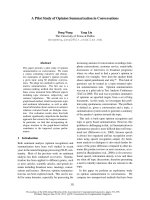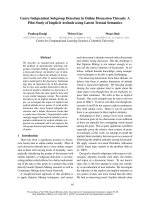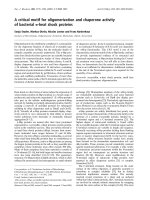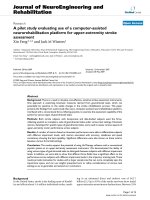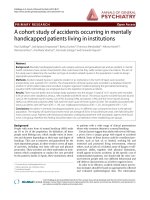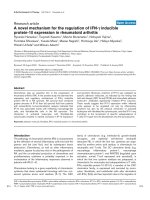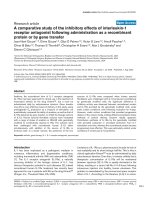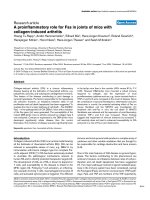Báo cáo y học: "A pilot study for augmenting atomoxetine with methylphenidate: safety of concomitant therapy in children with attention-deficit/hyperactivity disorder" pot
Bạn đang xem bản rút gọn của tài liệu. Xem và tải ngay bản đầy đủ của tài liệu tại đây (270.34 KB, 7 trang )
BioMed Central
Page 1 of 7
(page number not for citation purposes)
Child and Adolescent Psychiatry and
Mental Health
Open Access
Research
A pilot study for augmenting atomoxetine with methylphenidate:
safety of concomitant therapy in children with
attention-deficit/hyperactivity disorder
Gabrielle A Carlson*
1
, David Dunn
2
, Douglas Kelsey
3
, Dustin Ruff
3
,
Susan Ball
3
, Lisa Ahrbecker
3
and Albert J Allen
3
Address:
1
Department of Child and Adolescent Psychiatry, Stony Brook School of Medicine, Stony Brook, New York 11794-8790, USA,
2
Department of Psychiatry, Indiana University School of Medicine, Indianapolis, Indiana 46202, USA and
3
Lilly Research Laboratories, Eli Lilly
and Company, Indianapolis, Indiana 46268, USA
Email: Gabrielle A Carlson* - ; David Dunn - ;
Douglas Kelsey - ; Dustin Ruff - ; Susan Ball - ;
Lisa Ahrbecker - ; Albert J Allen -
* Corresponding author
Abstract
Background: This study examined augmenting atomoxetine with extended-release
methylphenidate in children whose attention-deficit/hyperactivity disorder (ADHD) previously
failed to respond adequately to stimulant medication.
Methods: Children with ADHD and prior stimulant treatment (N = 25) received atomoxetine (1.2
mg/kg/day) plus placebo. After 4 weeks, patients who were responders (n = 4) were continued on
atomoxetine/placebo while remaining patients were randomly assigned to either methylphenidate
(ATX/MPH) (1.1 mg/kg/day) or placebo augmentation (ATX/PB) for another 6 weeks. Patients and
sites were blind to timing of active augmentation. Safety measures included vital signs, weight, and
adverse events. Efficacy was assessed by ADHD rating scales.
Results: Categorical increases in vital signs occurred for 5 patients (3 patients in ATX/MPH, 2
patients in ATX/PBO). Sixteen percent discontinued the study due to AE, but no difference
between augmentation groups. Atomoxetine treatment was efficacious on outcome measures (P ≤
.001), but methylphenidate did not enhance response.
Conclusion: Methylphenidate appears to be safely combined with atomoxetine, but conclusions
limited by small sample. With atomoxetine treatment, 43% of patients achieved normalization on
ADHD ratings.
Published: 27 September 2007
Child and Adolescent Psychiatry and Mental Health 2007, 1:10 doi:10.1186/1753-2000-1-
10
Received: 20 February 2007
Accepted: 27 September 2007
This article is available from: />© 2007 Carlson et al; licensee BioMed Central Ltd.
This is an Open Access article distributed under the terms of the Creative Commons Attribution License ( />),
which permits unrestricted use, distribution, and reproduction in any medium, provided the original work is properly cited.
Child and Adolescent Psychiatry and Mental Health 2007, 1:10 />Page 2 of 7
(page number not for citation purposes)
Introduction
Pharmacological interventions are considered first-line
treatment for attention-deficit/hyperactivity disorder
(ADHD) [1]. The U.S. Food and Drug Administration
(FDA) has approved stimulant medications and atomoxe-
tine for the treatment of ADHD. Stimulant medications
have a long-established use and may partly work through
the dopaminergic neurotransmitter system. Atomoxetine
is a relatively new, nonstimulant medication that is a
potent selective inhibitor of the presynaptic norepine-
phrine transporter. Dysregulation in dopaminergic and
noradrenergic systems has been implicated in the patho-
genesis of ADHD [2].
Although stimulants and atomoxetine each have been
established as an effective monotherapy for the treatment
of ADHD, a number of clinical situations may arise that
would suggest the strategy of augmenting or combining
the 2 treatments. Augmentation often occurs when a
patient responds to an initial intervention but continues
to have residual symptoms that cause significant distress
or impairment. Tolerability concerns also play a role in
the decision to add a second medication. After reaching a
specific dose level, a patient may begin to experience
adverse events if there is further increase in dosage. For
example, a child could need additional dosing of a stimu-
lant medication for management of symptoms in the
evening, but such an increase might lead to insomnia.
Thus, the different profiles of the medications can be used
together to manage adverse events within the goal of
improving the psychiatric illness.
Reflecting these real-world situations, rates of concomi-
tant psychotropic medications have increased substan-
tially over the past decade. Among youths being treated
with stimulants, Bhatara et al [3] reported that prescrip-
tion patterns of combining stimulants with other psycho-
tropics have increased from 4.8% in 1993–94 to 24.7% in
1997–1998. Despite the increase in the practice, empirical
support for the safety and efficacy of concomitant treat-
ments remain limited [4]. Controlled trials for combina-
tion treatment of ADHD have been conducted primarily
to combine stimulants with tricyclic antidepressants. An
earlier study of desipramine and methylphenidate (MPH)
suggested synergistic effects for the combination that were
superior to either intervention alone [5]. However, the
combination treatment also was associated with more
adverse events than the monotherapies [6]. Case reports
of combination atomoxetine and stimulant treatments
have provided promising findings, but these reports also
underscore the need for systematic study [7].
Approximately 30% of children fail to respond adequately
to a trial of stimulant medication [8]. As children with an
inadequate response to stimulants are likely to be pre-
scribed atomoxetine, the present study examined the ini-
tial response to atomoxetine followed by augmentation
with either extended-release (OROS) methylphenidate
(MPH) or placebo. Our primary objective was to examine
the safety of this augmentation strategy for atomoxetine in
children with ADHD.
Methods
Patient selection
Patients were children ages 6 through 12 recruited from 5
outpatient centers. To be eligible for the study, children
had to meet the following criteria: a DSM-IV diagnosis of
ADHD, any type; a rating on the ADHD Rating Scale Ver-
sion IV Parent Reported-Investigator Rated version (ADH-
DRS-IV-Parent:Inv) [9] of at least 1.5 standard deviations
above age and gender norms; and a severity rating of at
least moderate on the Clinical Global Impressions Sever-
ity Scale (CGI-S). Additionally, they must have experi-
enced a prior history (preceding 12 months) of
insufficient response to an adequate stimulant trial, which
was defined as a gradual titration of stimulant medication
for at least two weeks at specified doses for each of the
medication. Inadequate response was determined by the
child's prescribing physician who also documented his or
her opinion that a change in treatment was needed.
Children were excluded from participating in the study if
they weighed less than 22 kg or more than 60 kg at study
entry; had any other Axis I diagnosis, including pervasive
developmental disorder, mood, or anxiety disorder; had
any medical conditions that would contraindicate the use
of either atomoxetine or extended-release methylpheni-
date, or used any concomitant psychotropic or excluded
medications. The presence of comorbid oppositional defi-
ant disorder was not an exclusion criterion. Children who
had a history of intolerance or nonresponse to atomoxet-
ine were excluded because of the ethical reason that they
should not be enrolled in an augmentation study in
which they have demonstrated inadequate response to
both treatments. All patients were required to be free of
any excluded medications for at least 5 days prior to base-
line ratings and randomization.
Each site's institutional review board approved the con-
duct of the study, which was developed in accordance
with the ethical standards of Good Clinical Practice
(GCP) and the Declaration of Helsinki, as revised in 2000
[10]. Parents or legal guardians of all subjects provided
written informed consent, and the patients gave verbal
assent to participate in the study.
Assessment procedures
At the initial screening visit, patients underwent a thor-
ough diagnostic and medical examination. The diagnosis
of ADHD was determined using the semi-structured clini-
Child and Adolescent Psychiatry and Mental Health 2007, 1:10 />Page 3 of 7
(page number not for citation purposes)
cal interview, KIDDIE-SADS-PL version [11], and was
confirmed by a child psychiatrist. The medical evaluation
included medical history, physical exam, routine chemis-
try, hematology, urinalysis, and electrocardiograms.
During the course of treatment, safety was assessed by
obtaining vital signs, weight, spontaneous adverse event
reports, and concomitant medications at each visit. Illness
severity measures included the ADHDRS-IV-Parent:Inv;
Clinical Global Impression Scale – Improvement (CGI-I)
[12] ratings; the Weekly Parent Ratings of Evening and
Morning Behavior-Revised (WREMB-R); and the Conners
Parent Rating Scale Revised, Short-Form (CPRS-R:S) [13].
With the exception of the WREMB-R, these outcome
measures have been established as valid and reliable
within the ADHD field, and they are scored so that higher
scores indicate greater symptom severity. The WREMB-R is
a more recent instrument in which a parent rates 11
behaviors for their severity during the morning and
evening hours, and it has shown sensitivity to treatment
effects in prior clinical trials [14]. Overall improvement
also was rated by clinicians using the CGI-I, which con-
sists of a 7-point scale where 1 = "very much improved"
and 7 = "very much worse". The safety and efficacy meas-
ures were repeated again at the end of treatment or when
patients discontinued the study.
Study design
The study design consisted of 3 sequential phases: an eval-
uation/screening phase, a double-blind 4-week acute
treatment (study phase 1); and a 6-week, double-blind,
combination treatment phase (study phase 2). At visit 2
(treatment week 1), all patients were started on open-
label atomoxetine and given a pill placebo. Atomoxetine
was titrated to a target dose of 1.2 mg/kg/day (maximum
dose 1.4 mg/kg/day). Neither the investigator nor the
patients knew when the onset of active augmentation
would occur as the investigator's protocol did not specify
the timing of active augmentation. Another protocol that
specified the onset of augmentation was mailed directly to
the investigator's institutional review board for full disclo-
sure. After 4 weeks on placebo, patients' illness severity
was compared with their baseline using the above scales.
If patients were rated on the CGI-I scale as 1 or 2 (much
or very much improved), they were classified as remitters
and were maintained on placebo. If patients continued to
have substantial symptoms, they were then randomly
assigned via an interactive voice response system to
receive either extended-release methylphenidate or pla-
cebo. Dose for OROS methylphenidate was titrated to a
target dose of 1.08 mg/kg/day (maximum dose 1.2 mg/
kg/day). All patients continued with their open label ato-
moxetine dose during the active augmentation treatment
phase. During study phase 1, patients were seen after 14
days and then weekly for 2 visits (4 weeks total). During
study phase 2, they were seen weekly for 2 weeks, and
then 1 month later (6 weeks).
Statistical methods
The power calculations for the study were based on the
primary objective of safety by estimating the number of
patients who would be required to demonstrate a safety
signal in categorical changes in vitals. Based on the
assumption of 5% of patients would have a categorical
change in vitals on atomoxetine, 85 subjects were esti-
mated to be required for an 80% power to detect a eight-
fold increase in categorical changes. However, it was diffi-
cult to find a sample of children who had stopped stimu-
lant treatment, were not intolerant of stimulants, and had
not already been treated with atomoxetine. Thus, the final
sample size was 25, which caused the study to be under-
powered to detect categorical differences between groups.
Safety and tolerability outcomes were reported with fre-
quency counts. Paired t tests were used to examine
whether mean changes from baseline to the end of study
phase 1 and mean changes from baseline to study phase 2
were significantly different from zero. Categorical changes
in vital signs were defined as follows: (1) for diastolic and
systolic blood pressure, an increase of at least 5 mmHg to
above the 95
th
percentile based on age, gender, and
height-adjusted National Institute of Health norms [15];
(2) for pulse, an increase of at least 25 to a value of at least
110 bpm.
Efficacy outcome measures were conducted on the intent-
to-treat sample using a last-observation-carried-forward
method. Patients were classified into 3 groups: atomoxet-
ine/methylphenidate, atomoxetine/placebo excluding
early responders (who were not randomized), and atom-
oxetine/placebo including early responders. Efficacy was
analyzed using a repeated measure analysis of covariance
(ANCOVA) comparing changes on the ADHDRS-IV-Par-
ent:Inv total score from initial baseline, at the end of study
phase 1, and the end of study phase2. The initial baseline
score was the covariate, and treatment and investigator
were fixed effects. Effect sizes were also calculated on the
secondary outcome measures to determine the overall
treatment response (10-week treatment from baseline to
study end-point) and the incremental effect size (6-week
double-blind randomization to study end-point).
Efficacy was examined descriptively by classifying patients
individually based on their T-score obtained from the
ADHDRS-IV-Parent:Inv total at the end of study phase 1
and at the end of study phase 2. Patients were classified as
normalizers if their scores at the end of the study phases
were within 1 standard deviation of the normal range (i.e.,
T-score ≤ 60). The frequency of normalization was then
summed to determine the rate of those who did not
Child and Adolescent Psychiatry and Mental Health 2007, 1:10 />Page 4 of 7
(page number not for citation purposes)
improve, who transiently improved (normalized at end of
study phase 1, but not study phase 2), or obtained/main-
tained improvement (normalized at end of both study
phases).
Results
Twenty-five children met the inclusion criteria. All but 1
patient (who withdrew) entered into the 4-week treat-
ment phase with atomoxetine and placebo (PBO). Mean
age of this sample was 9.6 years old (sd = 1.8); 83% were
male, and 83% were Caucasian. Nineteen (79%) met the
criteria for ADHD combined type, and 12 (50%) had a
comorbid oppositional defiant disorder. Of the 25 chil-
dren, 4 children discontinued the study prior to randomi-
zation (includes the child who withdrew); 4 were
classified as early responders during the initial atomoxet-
ine 4-week treatment and were not randomized (RESP-
ATX/PBO); 9 children were randomly assigned to
extended-release (OROS) methylphenidate (ATX/MPH);
and 8 were randomly assigned to placebo (ATX/PBO)
augmentation. Reasons for early discontinuation was for
adverse events (n = 2), perceived lack of efficacy (n = 1),
and physician decision (n = 1).
Safety and tolerability
Fourteen treatment-emergent adverse events (TEAEs)
occurred during the study (Table 1). Overall, there were
numerically fewer TEAE in the ATX/MPH group compared
with the ATX/PBO group. One TEAE was rated as severe
(irritability) and 4 patients (16%) discontinued the study
due to TEAEs. During study phase 1, 2 patients discontin-
ued due to TEAEs (mydriasis, vomiting); during study
phase 2, 1 patient discontinued in the ATX/MPH group
(supraventricular extrasystoles) and 1 patient in the ATX/
PBO (irritability). The most common TEAEs were initial
insomnia, vomiting, headache, nausea, and rhinitis. No
deaths or serious adverse events occurred in the study.
Categorical increases in vital signs occurred for 3 patients
in the ATX/MPH group (1 systolic and diastolic blood
pressures, 1 diastolic blood pressure, and 1 pulse rate) and
for 2 patients in the ATX/PBO group (1 for pulse, 1 for
systolic blood pressure) (Table 2). The sample sizes were
too small to test for statistical significance. Overall, from
study baseline to treatment endpoint, there was no statis-
tically significant difference within patients or between
groups in changes in blood pressure or pulse rate. Patients
in the ATX/PBO group had a mean systolic BP change of -
0.25 mm/Hg (sd = 10.0), a mean diastolic BP change of -
1.83 (sd = 7.5), and a mean pulse change of -2.0 bpm (sd
= 12.3). For patients in the ATX/MPH group, the mean
change in systolic BP was 2.1 mm/Hg (sd = 11.2), in
diastolic BP was 3.0 (sd = 8.5), and in pulse (sd = 5.0, sd
= 12.6). There were significant differences between treat-
ment groups for weight with patients who were aug-
mented with placebo having a mean increase in weight of
0.84 kg compared with patients in the ATX/MPH group
who had a mean decrease in weight of 0.89 kg (P ≤ .05).
The mean atomoxetine dose at endpoint was 1.07 mg/kg
(sd = 0.12) for the ATX/MPH group and 1.09 (sd = 0.12)
for the ATX/PBO group; the mean methylphenidate dose
was 1.02 mg/kg for the group randomized to methylphe-
nidate combination.
Efficacy outcomes
An overall treatment response to atomoxetine was found
at the end of study phase 1 and study phase 2 (Figure 1),
as demonstrated by the primary efficacy measure, the
ADHDRS-IV-Parent: Inv total score. After 1 week of com-
bination therapy, patients in the ATX/MPH group were
significantly more improved than patients in the ATX/
Table 1: Frequency of treatment-emergent adverse events (TEAEs) from baseline to treatment endpoint by treatment group
Event ATX + MPH N = 9 n (%) ATX + PBO N = 12 n (%)
Initial insomnia 1 (11.1) 2 (16.7)
Rash 1 (11.1) 0 (0.0)
GI discomfort 1 (11.1) 0 (0.0)
Cardiac SE 1 (11.1) 0 (0.0)
Toothache 1 (11.1) 0 (0.0)
Vomiting 1 (11.1) 2 (16.7)
Abdominal pain 0 (0.0) 1 (8.3)
BP Increase 0 (0.0) 1 (8.3)
Hand fracture 0 (0.0) 1 (8.3)
Headache 0 (0.0) 2 (16.7)
Insomnia 0 (0.0) 1 (8.3)
Irritability 0 (0.0) 1 (8.3)
Nausea 0 (0.0) 2 (16.7)
Rhinitis 0 (0.0) 2 (16.7)
Key: GI, gastrointestinal; SE, supraventricular extrasystoles; BP, blood pressure
No significant differences were found between groups.
Child and Adolescent Psychiatry and Mental Health 2007, 1:10 />Page 5 of 7
(page number not for citation purposes)
PBO group, excluding the early responders (P ≤ .05), but
there were no statistically significant group differences five
weeks later at the end of the 10-week study. Atomoxetine
treatment either alone or in combination with methyl-
phenidate was associated with large effect sizes on the
ADHDRS-IV-Parent: Inv total score (Table 3), which
showed that atomoxetine treatment resulted in a mean
improvement of 1.3 standard deviations above the base-
line total score. Patients in the ATX/PBO group demon-
strated significant overall improvement on the WREMB-
PM subscale scores, but not the WREMB-AM subscale
scores. Overall improvement associated with atomoxetine
treatment was shown by changes in the CGI ratings and
CPRS ratings within groups, but there was no significant
incremental improvements within groups on these meas-
ures during the double-blind phase nor were there signif-
icant differences between groups at study endpoint (Table
3).
After converting the ADHDRS-IV-Parent:Inv total score to
a T-score, patients were classified by their response status
as to whether they normalized or not. Across all patients,
38.1% did not meet normalization criteria during the
study, 19.0% transiently normalized (met criteria at end
of study phase 1), and 23.8% did not score in the normal
range after study phase 1 but did at study endpoint. Over-
all, 42.9% either normalized by the end of study phase 1
and maintained improvement or had obtained normali-
zation by the end of study phase 2.
Discussion
To our knowledge, the present pilot study is the first pla-
cebo-controlled study of augmentation of atomoxetine
Table 2: Values of Vital Signs for Patients who met Criteria for Categorical Change
Parameter Augmentation
Treatment
Augmentation
Baseline
Categorical
Change Value
Categorical
Change
Duration of
Augmentation
Blood pressure (mm/Hg)
Patient 1 MPH 84/56 110/86 D 1 week
Patient 2 MPH 110/53 124/74 S & D 6 weeks
Patient 3 PBO 108/78 110/90 D 2 weeks
Pulse Rate (bpm)
Patient 1 MPH 84 114 P 2 weeks
Patient 2 PBO 78 112 P 2 weeks
Categorical change defined as follows: (1) for diastolic and systolic blood pressure, an increase of at least 5 mmHg to above the 95
th
percentile
based on age, gender, and height-adjusted National Institute of Health norms [15]; (2) for pulse, an increase of at least 25 to a value of at least 110.
Abbreviations: MPH, methylphenidate; PBO placebo, D, met categorical change definition for diastolic blood pressure; S met categorical change
definition for systolic blood pressure; P met categorical change definition for pulse.
Table 3: Effect sizes for Efficacy Outcome Measures Across Treatment Phases
Measures ATX +MPH (n = 9) ATX + PBO (excl. ER) (n = 8) ALL ATX + PBO (n = 12)
ADHD RS-IV-Parent:Inv T score
Overall effect 1.3*** 1.2** 1.3***
Incremental effect 0.05 0.18 0.03
WREMB-AM
Overall effect 0.60 0.82 0.79
Incremental effect 0.43 0.07 0.11
WREMB-PM
Overall effect 0.56 0.70 0.94*
Incremental effect 0.33 0.01 0.02
CGI-Severity
Overall effect 1.3* 1.3** 1.4**
Incremental effect .34 .38 0.25
Conner Parent Rating Scale
Overall effect 1.2* 0.80** 0.98***
Incremental 0.18 0.09 0.07
Key: ER, Early responders; ADHD-RS-IV-Parent:Inv, ADHD Rating Scale Parent Report Investigator Rated; WREMB, Weekly Ratings Evening and
Morning Behaviors. Note: Overall effect size was from baseline to study end-point (10 weeks ATX treatment); Incremental effect size from double-
blind randomization to study end-point (6 weeks augmentation treatment).
*P ≤ .05, within group; **P ≤ .01, within group; *** P ≤ .001, within group from baseline
Child and Adolescent Psychiatry and Mental Health 2007, 1:10 />Page 6 of 7
(page number not for citation purposes)
with extended-release (OROS) methylphenidate.
Although the study was initially intended to enroll a larger
sample size, the inclusion eligibility criteria resulted in
difficult recruitment. Specifically, many children who
have experienced poor response to stimulants have
already been treated with atomoxetine, and children who
were naïve to treatment obviously could not be assessed
for a prior history of stimulant response. The enrollment
of the 25 children occurred across 5 centers; therefore,
adding more research sites was not considered to be a via-
ble solution, which then led to the study being closed.
Given the small study sample, particularly in the combi-
nation treatment groups, the findings must be considered
preliminary.
Analysis of the safety results did not reveal safety concerns
that would preclude combining atomoxetine with
extended-release methylphenidate over a 10-week period.
There were no unexpected safety findings, and the
observed changes in blood pressure were considered not
to be clinically significant. Tolerability was favorable for
both atomoxetine alone and the combination of atomox-
etine and methylphenidate, as shown by the low fre-
quency of treatment-emergent AEs as well as the overall
16% rate of discontinuation due to AEs.
The safety and tolerability findings from this study mirror
previous findings of cardiovascular effects in patients who
have received combined treatment as a portion of a clini-
cal trial design. In a study optimizing the treatment of
ADHD in 25 adults, the combination of atomoxetine and
methylphenidate resulted in small statistically significant
mean increases in pulse and heart rate. Categorical data
analyses found one case of mild cardiac flutter in the con-
text of normal pulse and blood pressure readings, and one
case of systolic blood pressure increase of at least 15
mmHg to over 150 mmHg on one occasion (data on file,
Eli Lilly and Company). In a study of healthy adults, the
addition of atomoxetine to methylphenidate did not
result in additive increases in heart rate or blood pressure
[16]. For children with ADHD who were undergoing a
switch from atomoxetine to methylphenidate, during the
brief period of combined treatment, categorical changes
in blood pressure and heart rate were within generally
expected ranges [17].
With regard to efficacy, in a previous cross-over study
comparing stimulants and atomoxetine, 45% of the chil-
dren who did not respond to stimulants showed a ≥ 40%
reduction in their ADHDRS-IV-Parent: Inv total score fol-
lowing atomoxetine treatment [18]. Consistent with this
finding, in this sample of patients who had previously
experienced an insufficient response to stimulant treat-
ment, 43% demonstrated normalization of their ADHD
symptoms following the 10-week atomoxetine treatment.
On each measure, patients significantly improved in their
core ADHD symptoms while taking atomoxetine and pla-
cebo during the first 4 weeks. The addition of methylphe-
nidate initially significantly improved the patients'
response in the first week, but this significant finding was
evident only when excluding the early responders who
were maintained on placebo. One of the early responders
had significant variability by showing an initial response
(32 point improvement) but then substantially worsening
(22 points) by the end of treatment so that the patient was
an eventual nonresponder. Overall, there was no signifi-
cant increase in efficacy from the combined phase.
Given the small sample of this study, definitive conclu-
sions on the effects of combining these medications
would be premature, and the present findings can be
applied only to children with an inadequate stimulant
response. Nonetheless, the findings of the present study
can provide guidance to the physician who is faced with
patients with ADHD who are not responding sufficiently
to stimulant treatment. Cardiovascular responses to the
combination of atomoxetine and OROS methylphenidate
were only minimally different from response to atomoxe-
tine alone. These preliminary data suggest that atomoxet-
ine appears to be safe when combined with extended-
release (OROS) methylphenidate over the short-term (6
weeks). The addition of atomoxetine to enhance a partial
response to stimulants maybe worth examining further in
the future.
Competing interests
Research was funded by Eli Lilly and Company, Indiana-
polis, IN. Dr. Carlson has received research support or has
ADHDRS-IV-Parent:Inv mean total scores (SE) across treat-ment weeksFigure 1
ADHDRS-IV-Parent:Inv mean total scores (SE) across treat-
ment weeks. *P ≤ .05, atomoxetine and placebo (excluding
early responders) vs atomoxetine and methylphenidate.
Publish with BioMed Central and every
scientist can read your work free of charge
"BioMed Central will be the most significant development for
disseminating the results of biomedical research in our lifetime."
Sir Paul Nurse, Cancer Research UK
Your research papers will be:
available free of charge to the entire biomedical community
peer reviewed and published immediately upon acceptance
cited in PubMed and archived on PubMed Central
yours — you keep the copyright
Submit your manuscript here:
/>BioMedcentral
Child and Adolescent Psychiatry and Mental Health 2007, 1:10 />Page 7 of 7
(page number not for citation purposes)
consulted with the following companies: Abbott Labora-
tories, Cephalon, Eli Lilly and Company, Janssen, McNeil,
Otsuka, and Shire Pharmaceuticals. Dr. Dunn has
received research support or has served on the speaker's
bureaus of the following companies: AstraZeneca, Eli Lilly
and Company, NIH, Otsuka, and Pfizer Pharmaceuticals.
Drs. Kelsey, Ruff, Ball, and Allen and Ms. Ahrbecker are
employees of and/or shareholders of Eli Lilly and Com-
pany.
Authors' contributions
GAC, DD, AJA, DR, and DK and LA developed and imple-
mented the clinical trial. GAC, DD, DK, SB, and AJA and
LA developed the content outline, developed the design of
analyses, and participated in interpretation of data. Statis-
tical analyses were directed by DR. All authors partici-
pated in writing team meetings and contributed to the
first draft. All authors have also read and approved the
final manuscript version.
Acknowledgements
The authors thank the participants and their families for their involvement
in the study. We would also like to acknowledge the contributions of our
co-investigators, Dr. Raun Melmed, Dr. Robert Lipetz, and Dr. Lawrence
Sher. As part of the written informed consent, patients and their parents
or legal guardians were given a data privacy statement regarding the use of
personal health information.
References
1. Biederman J, Spencer T, Wilens T: Evidence-based pharmaco-
therapy for attention-deficit hyperactivity disorder. Int J Neu-
ropsychopharmacol 2004, 7(1):77-97.
2. Faraone SV, Biederman J: Neurobiology of Attention-Deficit
Hyperactivity Disorder. Biol Psychiatry 1998, 44:951-958.
3. Bhatara V, Feil M, Hoagwood K, Vitiello B, Zima B: National trends
in concomitant psychotropic medication with stimulants in
pediatric visits: Practice versus knowledge. J Attent Disord 2004,
7(4):217-226.
4. Safer DJ, Zito JM, dosReis S: Concomitant psychotropic medica-
tions for youths. Am J Psychiatry 2003, 160:438-449.
5. Carlson GA, Rapport MD, Kelly K, Grayson P, Pataki CS: Methyl-
phenidate and desipramine in hospitalized children with
comorbid behavior and mood disorders: separate and com-
bined effects on behavior and mood. J Child Adolesc Psychophar-
macol 1995, 5:191-204.
6. Pataki CS, Carlson GA, Kelly KL, Rapport MD, Biancaniello TM: Side
effects of methylphenidate and desipramine alone and in
combination in children. J Am Acad Child Adolesc Psychiatry 1993,
32:1065-72.
7. Brown TE: Atomoxetine and stimulants in combination for
treatment of attention deficit hyperactivity disorder: Four
case reports. J Child Adolesc Psychopharmacol 2004, 14(1):129-136.
8. Spencer T, Biederman J, Wilens T, Harding M, O'Donnell D, Griffin S:
Pharmacotherapy of attention-deficit hyperactivity disorder
across the life cycle: A literature review. J Am Acad Child Adolesc
Psychiatry 1996, 35:409-432.
9. DuPaul GJ, Power TJ, Anastopoulos AD, Reid R: ADHD Rating Scale-
IV: Checklists, Norms, and Clinical Impressions New The Guildford Press;
1998.
10. WMA. Declaration of Helsinki: Ethical principles for medical
research involving human subjects. World Medical Associa-
tion. First adopted in 1964; most recent revision in 2000 2000 [http://
www.wma.net/e/policy/b3.htm].
11. Kaufman J, Birmaher B, Brent D, Rao U, Flynn C, Moreci P, William-
son D, Ryan N: Schedule for Affective Disorders and Schizo-
phrenia for School-Age Children-Present and Lifetime
Version (K-SADS-PL): initial reliability and validity data. J Am
Acad Child Adolesc Psychiatry 1997, 36:980-988.
12. Guy W: ECDEU assessment manual for psychopharmacology, revised
Bethesda, MD: US Department of Health, Education, and Welfare;
1976.
13. Conners CK, Barkley RA: Rating scales and checklists for child
psychopharmacology. Psychopharmacol Bull 1985, 21:809-843.
14. Kelsey DK, Sumner CR, Casat CD, Coury DL, Quintana H, Saylor KE,
Sutton VK, Gonzales J, Malcolm SK, Schuh KJ, Allen AJ: Once daily
atomoxetine treatment for children with attention deficit
hyperactivity disorder, including an assessment of evening
and morning behavior: A double-blind, placebo controlled
trial. Pediatrics 2004, 114:e1-e8.
15. National High Blood Pressure Education Program Working Group:
Update on the 1987 task force report on high blood pressure
in children and adolescents: A working group report from
the national high blood pressure education program. Pediat-
rics 1996, 98:649-658.
16. Kelly RP, Yeo KP, Teng CH, Smith BP, Lowe S, Soon D, Read HA,
Wise SD: Hemodynamic effects of acute administration of
atomoxetine and methylphenidate. J Clin Pharmacol 2005,
45:851-855.
17. Quintana H, Cherlin E, Duesenberg D, Bangs M, Ramsey J, Feldman P,
Allen AJ, Kelsey D: Transitioning from methylphenidate or
amphetamine to atomoxetine in children and adolescents
with attention-deficit/hyperactivity disorder – a preliminary
tolerability and efficacy study. Clin Ther 2007, 29(6):1168-1177.
18. Newcorn J: Atomoxetine and psychostimulants for ADHD: Is
there differential response? Oral presentation given at the Amer-
ican Academy Child and Adolescent Psychiatry national conference,
Washington, DC; 2004.
